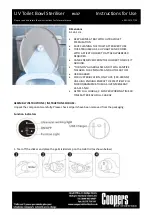
OPERATION
• Always disconnect power before performing any work on the disinfection system.
• Regularly inspect your disinfection system to ensure that the power indicators are
on and no alarms are present.
• Replace the UV lamp annually to ensure maximum disinfection.
• Always drain the reactor chamber when closing a seasonal residence or leaving the
unit in an area subject to freezing temperatures.
Operating & Maintenance Instructions:
Caution: prior to performing any work on the
disinfection system, always disconnect the
power supply first.
UV Lamp Replacement :
NOTE: RESET LAMP LIFE TIMER AFTER LAMP
REPLACEMENT (pg. 11)
1. DO NOT USE WATER DURING THIS PROCEDURE.
Lamp replacement is a quick and simple procedure
requiring no special tools. The UV lamp must be
replaced after 9,000 hours of continuous operation
(approximately one year) in order to ensure adequate
disinfection.
2. Disconnect main power source and allow the unit to cool
down for 10 minutes. Remove connector and lamp
from the reactor chamber. Separate the lamp from the
connector (Figure 2B). Do not twist the lamp from the
connector, simply slide the two apart. Avoid touching
the lamp on the glass portion. Handling the lamp at
the ceramic ends is acceptable, however if you must
touch the lamp glass, please use gloves or a soft
cloth. Fully remove the lamp from the reactor chamber
being careful not to angle the lamp as it is removed from
the chamber. If the lamp is removed on an
angle, pressure will be applied on the inside
of the quartz sleeve, causing the sleeve to
fracture.
3. To install a new lamp, first remove the lamp
from its protective packaging, again being
careful not to touch the lamp glass itself.
Carefully insert the lamp into the reactor vessel (actually
inside the quartz sleeve) (Figure 2C). Insert the lamp fully
into the chamber leaving about two inches of the lamp
protruding from the chamber. Next, attach the connector
to the UV lamp (Figure 2B). For Lamp 1 replacement, it is
important to remember the lamp is not keyed so it must
be ensured that the lamp wires do not interfere with the
UV sensor detection as low UV alarms could result in Hi-
Flo Monitored systems. The two wires should be oriented
furthest away from the sensor port. Ensure the connector
FIGURE 2A
FIGURE 2B
FIGURE 2C
8
Warning:
Always shut-off water flow and
release water pressure before servicing.

























